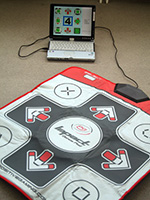2008 - open-end
Budget resources of KMRC
Basic understanding of magnitudes and numbers is necessary for everyday life. Therefore, it is of great importance for children to acquire a solid basis of numerical knowledge at an early age. For this reason, a large number of numerical trainings have been developed – none of which made use of computer-aided teaching and learning methods.
 The aim of the project “Media-support for arithmetic learning” is to apply technical and methodological expertise at the KMRC on computer-aided learning on trainings of the cognitive basics of mathematics. This project is planned and carried out in cooperation of two teams, headed by Prof. Cress (KMRC Lab "Knowledge Construction") and Prof. Nuerk (Institute of Psychology at the University of Tuebingen, Department of Diagnostics and Cognitive Neuropsychology) to provide the highest possible expertise in both research domains. Additionally, a position as research assistant was established that will work as a link between the cooperating teams.
The aim of the project “Media-support for arithmetic learning” is to apply technical and methodological expertise at the KMRC on computer-aided learning on trainings of the cognitive basics of mathematics. This project is planned and carried out in cooperation of two teams, headed by Prof. Cress (KMRC Lab "Knowledge Construction") and Prof. Nuerk (Institute of Psychology at the University of Tuebingen, Department of Diagnostics and Cognitive Neuropsychology) to provide the highest possible expertise in both research domains. Additionally, a position as research assistant was established that will work as a link between the cooperating teams.
Studies carried out in the project will include training of magnitude comprehension, the spatial representation of numbers, and the place-value-system. To produce a physical-spatial connection between numbers and space and thereby aid the training process, digital dance mats and interactive whiteboards will be used. This approach is based on the assumption that bodily activities promote the effectiveness of task processing and thereby reinforce training effects. On the long run, the project’s aim is to integrate different types of input and output media into the training process and to develop a wide range of training programs that can easily be employed in an educational environment.
For general aspects of the embodied representation of numeries and and first steps to implement those to remedial calculating classes please the the project "Embodied learning of numerosities and its use in school contexts". For futher aspects in diagnostics and intervention please see the project "Diagnostic and web-based intervention in mathematics impairments after elementary school".